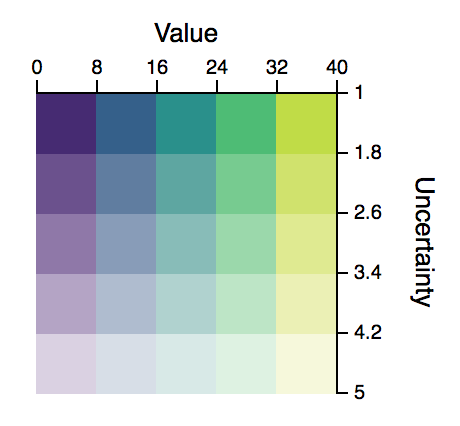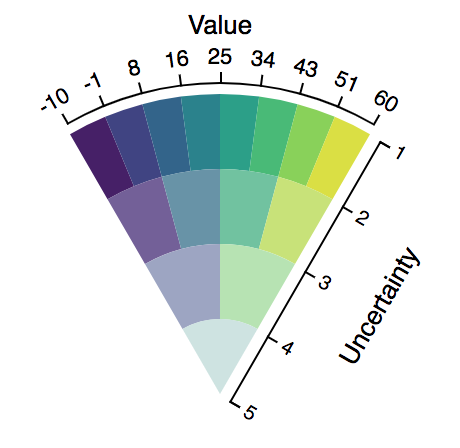Value-Suppressing Uncertainty Palettes (VSUPs)
Code for generating Value-Suppressing Uncertainty Palettes for use in D3 charts. You can find the research paper about VSUPs on our website.
Examples
These examples are served from the examples directory.
- Flights: https://uwdata.github.io/vsup/examples/flights.html
- Polling: https://uwdata.github.io/vsup/examples/polling.html
- Virology: https://uwdata.github.io/vsup/examples/virology.html
Citation
If you use this module for a publication, please cite VSUPs as:
@inproceedings{2018-uncertainty-palettes, title = {Value-Suppressing Uncertainty Palettes}, author = {Michael Correll AND Dominik Moritz AND Jeffrey Heer}, booktitle = {ACM Human Factors in Computing Systems (CHI)}, year = {2018}, url = {http://idl.cs.washington.edu/papers/uncertainty-palettes},}Installation
yarn add vsup or include the library directly from jsdelivr as https://cdn.jsdelivr.net/npm/vsup.
Usage
Quantization <>
A quantization defines how values or objects of the form {u: number, v: number} (uncertainty and value) are quantized. They are used instead of a domain in VSUP scales.
This module supports three different quantizations: linearQuantization, squareQuantization, and quantization.
vsup.linearQuantization
This is a wrapper around d3.scaleQuantize.
vsup.squareQuantization
Defines a quantization into a rectangular matrix of value and uncertainty.
The constructor takes a single argument n, the number of rows and columns.
var q = vsup;q is then a function that can be used to discretize uncertainties and values.
> ;u: 0 v: 016666666666666666The quantization has the following methods:
rangenmatrixdatauncertaintyDomainvalueDomain
vsup.quantization
Similar to squareQuantization but creates a tree quantization. The constructor takes two arguments branchingFactor and treeLayers.
The quantization has the following methods:
rangebranchinglayerstreedatauncertaintyDomainvalueDomain
Scales <>
The interface to create a scale mirrors scales in D3. The difference of VSUP scales is that they use a quantization instead of a domain. The range can be set to any color range.
The constructor takes three optional arguments: mode (usl, us, ul), range, and quantization. It returns a function that takes two arguments value and uncertainty.
For example
var s = vsup;s is now a function that takes two arguments
> ;"rgb(137, 214, 99)"The scale has the following methods:
rangeto get or set the color range (e.g.d3.interpolateViridis)colorListcolorDistsmodequantize
Legends <>
This module implements three kinds of legends (simpleLegend, heatmapLegend, and arcmapLegend) corresponding to the three quantization types.
To add a legend to the DOM, create a legend and attach it to an element. For example:
var legend = vsup;svgYou can find example code in test/legend.html.
vsup.legend.simpleLegend
A simple legend for linear quantizations.

vsup.legend.heatmapLegend
A rectangular legend for tree quantization or square quantization.

vsup.legend.arcmapLegend
A legend for a tree quantization.

Developers
Make a new release
- Test the examples in
test yarn versionnpm publishgit push --tags
